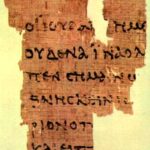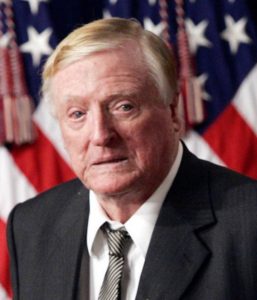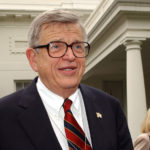John – the Eyewitness Gospel

John’s Gospel account reflects intimate knowledge of someone who was there. The Gospel of John is widely believed to be an eyewitness account written independently of the Synoptic Gospels.
Oldest of the fragments of the Gospel of John are dated to as early as 125 AD, possibly from the original manuscript text. John’s account is believed to have been written when John was in his 90s, a few short years before he died in approximately 100 AD.
Some assert that the Disciple John was not the actual author, rather someone else wrote it for him. If indeed that is the case, advanced age may have required someone else to write the words on his behalf.
Like the other three Gospels, the author does not specifically identify himself. One reason for no authorship can be attributed to the Jewish literary protocol of that era not to pen a name to literary works.[2]
Possibilities of authorship can be narrowed to the inner circle of Jesus – Peter, James and John. Only these three Disciples were chosen by Jesus to be with him during the Transfiguration and his final prayer on the Mount of Olives.[3]
James was executed decades before John’s Gospel was written excluding him as a possibility.[4] Peter can be ruled out because he is identified as the one who motioned to John leaning on the chest of Jesus asking for more details about the betrayer among them.[5]
Only John is left. By deduction, John is the probable Disciple author of the Gospel, but that is not the only factor that points to him.

Compared to the parallel Jewish writing style of Matthew, Mark and Luke, John is written chronologically. Naturally timeline variations occur with the sequence of events using the annual Feasts in Jerusalem.[6]
Times in the Gospel followed Passover observances where there were three.[8] In some scenarios, events included the exact hour.
One of the most compelling authenticity examples is the scene fr0m the Resurrection morning events. It begins at the point when Mary Magdalene and other women burst into the room telling John and Peter what they had seen and heard at the empty tomb — the account begins when the author became personally involved.[9]
Ending the Gospel is a personal situation after breakfast on the Sea of Tiberias shore with the resurrected Jesus. A conversation is described that the author overheard between Jesus and Peter.[10]
Location details are so frequent, it is easy to map the journey of Jesus throughout his ministry. Precise locations within Jerusalem are identified, the “Sheep Gate a pool called Bethzatha in Aramaic, which has five covered walkways;“ “‘The Stone Pavement’ (Gabbatha in Aramaic)” and “the Roman governor’s residence” of Pilate.
“Cana in Galilee” is named three times, first where Jesus turned water to wine and is later identified as the hometown of Disciple Nathanael. Bethany is cited as the hometown of the siblings Mary, Martha and Lazarus as well as a place where John the Baptist performed baptisms.
Obscure locations are named: “Aenon near Salim” and a “Samaritan town called Sychar.” Other general areas places near Jerusalem are identified such as “the Kidron Valley” and the “Mount of Olives.
A strong clue to the identity 0f the book is when the author refers to “John the Baptist” only as “John” – there was no need to distinguish between another “John.” Many other personal names serve as yet another authenticity validation.
Some Disciples were identified as Andrew, Simon Peter, Philip, Nathanael, Thomas and ”Judas (not Judas Iscariot). Named also are two Pharisee members of the ruling Jewish council Nicodemus and Joseph of Arimathea; adversaries Caiaphas, Annas, and Pilate; and other followers of Jesus, Mary the wife of Clopas, Mary Magdalene and the siblings Mary, Martha and Lazarus.
Many quotes appear throughout the account, for example, Nicodemus said, “you are a teacher who has come from God.” Another is Mary Magdalene’s misunderstood exclamation’s to Peter and John, “They have taken the Lord from the tomb, and we don’t know where they have put him!”[11]
Doubting Disciple Thomas was quoted saying, “Unless I see the wounds from the nails in his hands, and put my finger into the wounds from the nails, and put my hand into his side, I will never believe it!” Days later, his excited utterance is again quoted upon seeing and touching the resurrected Jesus, “My Lord and my God!”[12]
On the Mount of Olives, “Simon Peter then, having a sword, drew it and struck the high priest’s slave, and cut off his right ear; and the slave’s name was Malchus.” Not just an ear, it was the right ear of the slave.[13]
Describing the crucifixion, “bearing His cross, went out to a place called the Place of a Skull, which is called in Hebrew, Golgotha, where they crucified Him, and two others with Him, one on either side, and Jesus in the center.”[14] Crucifixion witnesses were identified as the mother of Jesus (Mary), her sister (Salome, mother of John), Mary the wife of Clopas, Mary Magdalene and the Disciple author himself.[15]
Writing “Jesus did many other signs in the presence of his disciples, which are not written in this book.”[16] At the end of the Gospel, the author wrote:
JN 21:24 “This is the disciple who testifies to these things and who wrote them down. We know that his testimony is true.” (NIV)
Is the Gospel of John an actual eyewitness account?
Updated September 15, 2025.
This work is licensed under a Creative Commons Attribution-NonCommercial-NoDerivatives 4.0 International License.
REFERENCES:
[1] “Gospel of John.” Theopedia.com. Encyclopedia of biblical Christianity. n.d. <http://www.theopedia.com/Gospel_of_John> “The Book of John.” Quartz Hill School of Theology. n.d. <http://www.theology.edu/biblesurvey/john.htm> Smith, Barry D. “The Gospel of John.” Crandall University. n.d. <http://www.mycrandall.ca/courses/NTIntro/John.htm> “Crucifixion.” Jewish Encyclopedia. 2011. <http://www.jewishencyclopedia.com/articles/4782-crucifixion> Quartz Hill School of Theology. “Gospel of John.” Theopedia.com. “Gospel of John Commentary: Who Wrote the Gospel of John and How Historical Is It?” Biblical Archeology Society. 2019. https://www.biblicalarchaeology.org/daily/biblical-topics/new-testament/gospel-of-john-commentary-who-wrote-the-gospel-of-john-and-how-historical-is-it/>/ Ben C. “Gospel manuscripts – The manuscripts extant for the four canonical gospels.” TextExcavation.com. 2018. <http://www.textexcavation.com/gospelmanuscripts.html> “Synoptic Gospels.” Theopedia.com. Gloag, Paton J. Introduction to the Synoptic Gospels. pp 5, 9, 23-38. 1895. <http://catalog.hathitrust.org/Record/008728595> “The Book of Matthew.” Quartz Hill School of Theology. Mareghni, Pamela. “Different Approaches to Literary Criticism.” Ehow.com. 2014. <http://web.archive.org/web/20140628042039/http://www.ehow.com/about_5385205_different-approaches-literary-criticism.html “Gospel of John.” Theopedia.com. Fonck, Leopold. “Gospel of St. John.” The Catholic Encyclopedia.Vol. 8. 1910. New Advent. 2014. <http://www.newadvent.org/cathen/08438a.htm> “The Book of John.” Quartz Hill School of Theology. Smith, Barry D. “The Gospel of John.” Smith, B. D. “The Gospel of John.” F. 5.3.
[2] Hoffe , Peter Charles. “Plagiarism.” University of Massachusetts Amherst. 2013. <https://web.archive.org/web/20120709005620/http://www.umass.edu/wsp/reference/conventions/plagiarism.html
[3] Rylands, John. “P52: A Fragment of the Gospel of John (a.k.a. John Rylands P457).” Trans. K. C. Hanson. KCHanson.com. photo. 2004. <http://www.kchanson.com/ANCDOCS/greek/johnpap.html> Kenyon, Frederic G. The Chester Beatty Biblical Papri Descriptions and Text of Twelve Manuscripts On Papyrus of the Greek Bible. p 40, John X, 31-XI, lO. photo. 1934. <https://www.google.com/url?sa=t&rct=j&q=&esrc=s&source=web&cd=&cad=rja&uact=8&ved=2ahUKEwiunOPjrcGBAxWKmmoFHdURD6wQFnoECBMQAQ&url=https%3A%2F%2Fchesterbeatty.ie%2Fassets%2Fuploads%2F2018%2F11%2FBiblical-Papyri-Descriptions-and-Texts-of-Twelve-Manuscripts-on-Papyrus-of-The-Greek-Bible-II-text-Opt.pdf&usg=AOvVaw10CaOofK-DYt13LtHoJguP&opi=89978449>
[3] Matthew 17:1; 26:36; Mark 1:29; 5:37; 9:2; 14:33; Luke 8:51; 9:28; 22:8; John 13:23-25.
[4] Acts. 12:2. “St. James.” Encyclopædia Britannica. 2020. <https://www.britannica.com/biography/Saint-James-son-of-Zebedee>
[5] John 13:23-25; 21:20.
[6] “St. John the Apostle.” Catholic News Agency. n.d. <https://www.catholicnewsagency.com/saint/st-john-the-apostle-671 “John the Apostle.” TheFamousPeople. n.d. <https://www.thefamouspeople.com/profiles/john-the-apostle-37257.php> “Gospel of John.” Theopedia.com.
[7] Sapir Avinoam. LSI Laboratory for Scientific Interrogation. <http://www.lsiscan.com/id37.htm
[8] John 2:13; 6:4; 11:55.
[9] John 20:2-10; 21:20-23.
[10] John 21.
[11] John 20.
[12] John 21:24-29.
[13] John 18:10.
[14] John 19:16-18. NJKV.
[15] John 19:25-27. NKJV. CR Matthew 27:36. Treloar, Adrian. “The Medicine of the Crucifixion.” Catholic Medical Quarterly. 2011. <http://www.cmq.org.uk/CMQ/2013/Feb/Crucifixion.html>
[16] John 20:30. NASB, NKJV. CR John 21:25.[17]


 Years ago in an appearance on CNBC, the distinguished moderator of NBC’s Meet the Press, the late Tim Russert, interviewed the late William F. Buckley. As a recognized intellectual, his biography is extremely impressive.
Years ago in an appearance on CNBC, the distinguished moderator of NBC’s Meet the Press, the late Tim Russert, interviewed the late William F. Buckley. As a recognized intellectual, his biography is extremely impressive.